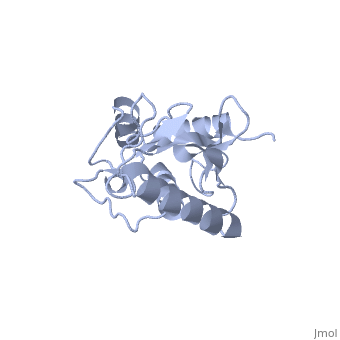Ubc9 is a ubiquitin conjugating enzyme (E2) whose function involves the transfer of ubiquitin or small ubiquitin-like modifier (SUMO) from ubiquitin activating enzyme (E1) to its designated substrate. is the only E2 enzyme specifically involved in SUMO transfer [1][2].
Structure
Murine/human Ubc9 exhibits a single domain structure consisting of both alpha helices and beta-pleated sheets (PDB: 1U9A). has been identified as the active residue and is located on a loop of amino acids (78-108) between beta sheet four and alpha helix two [1]. Amino acids surrounding the active site have been shown to play a role in catalysis of SUMO transfer to substrate via the suppression the the substrate lysine side chain pKa, which serves the purpose of nucleophile activation [3].
A crystal structure has shown that Ubc9 is the central protein in the SUMO-RanGAP1-Ubc9-Nup358 (PDB: 1Z5S), which forms in such a way as to enhance conjugation and transfer of the SUMO to substrate [4].
Along with the formation of a thioester bond to the substrate, Ubc9 can also interact noncovelently with SUMO. A crystal structure of the (PDB: 2UYZ) shows that the Ubc9 residues involved in this interaction are located at the end of helix one, on beta strand one, and along the following loop. These residues were shown to interact with the beta sheet of SUMO1 [5].
Function
Ubc9 is enzymatically involved in the SUMOylation process, as it is responsible for ligating the SUMO to the protein. If the reaction occurs in vitro, Ubc9 will ligate the SUMO directly to the substrate, while if the reaction occurs in vivo, the SUMO will be ligated to the conjugating enzyme (E3) and then ligated onto the substrate [6]. Initially in the SUMOylation pathway, a thioester bond is formed between the SUMO and the E1 enzyme via an ATP-dependent reaction. Next, the SUMO is transferred to the active cysteine of the E2, in this case, Ubc9. Finally, the SUMO is ligated to a lysine side chain amino group of the substrate, during which an E3 enzyme may or may not be recruited. The use of E3 mediated transfer serves functions such as increasing the specificity for the substrate to be SUMOylated [5].
Ubc9 has been found to be predominantly nuclear, with its N-terminal amino acids being integral to its localization. Ubc9 nuclear accumulation is vital for normal SUMOylation rates [2].
Kinetic analysis has shown that the Ubc9 amino acids , which are in close proximity to the active site Cys93, play a role in substrate recongnition within the thioester Ubc9-SUMO1 complex. These amino acids are not found in other E2 enzymes, making their involvement in SUMO conjugation unique to Ubc9 [7].
SUMOylation has been shown to enhance processes such as DNA methyltransferse 1 enzymatic activity, which has a major regulatory effect on gene transcription [8]. The transcription factor AP-2 is SUMOylated by Ubc9, a process which decreases the transcription activation potential of AP-2, thus having an effect on gene transcription, and therefore likely having an effect on gene expression as well [9].
Noncovalent interactions between Ubc9 and SUMO distant from the active site have been shown to be critical in the formation of SUMO chains, upon which in vivo functions such as metabolic regulation and signaling are dependent. Mutagenesis studies on the noncovalent Ubc9-SUMO1 complex have shown that Ubc9H20D and SUMO1E67R mutations cause inhibition of noncovalent interaction between the two, and thus inhibit complex formation. A similar interaction is seen in the Ubc9-SUMO2 complex [5]. Lack of noncovalent interaction between Ubc9 and SUMO2 has been shown to inhibit SUMO2 chain formation [5]. NMR studies of Ubc9 have demonstrated that noncovalent interactions between SUMO-1 and Ubc9 play a critical role in the transfer of SUMO-1 from the activating enzyme (E1) to the conjugating enzyme (E2) [10].
Disease
Expression of Ubc9 has been linked to human diseases such as cancer, neurodegenerative diseases, and heart diseases. Studies have shown Ubc9 to interact with tumor suppressor proteins such as p53, p63, and p73. Ubc9 expression has also been found to be fundamental in tumor progression and the prevention of apoptotic pathways [11]. Upregulation of Ubc9 has been shown to play an integral role in metastasis and progression of various cancers, making it a target for cancer treatment development [12][13].

